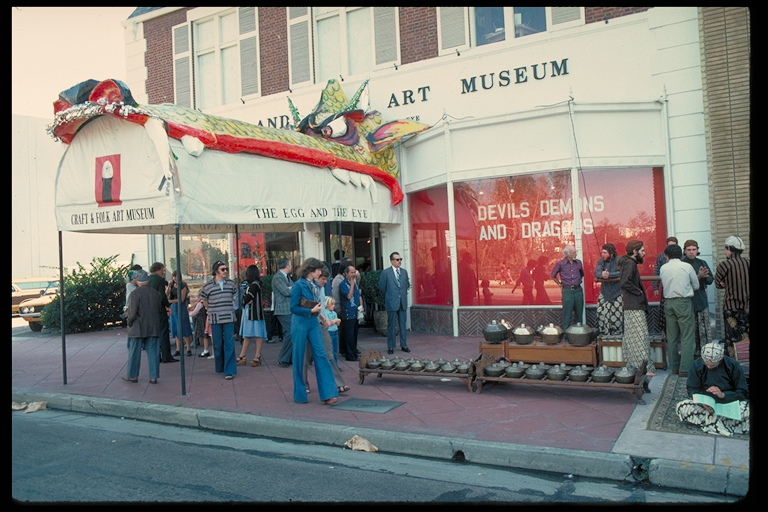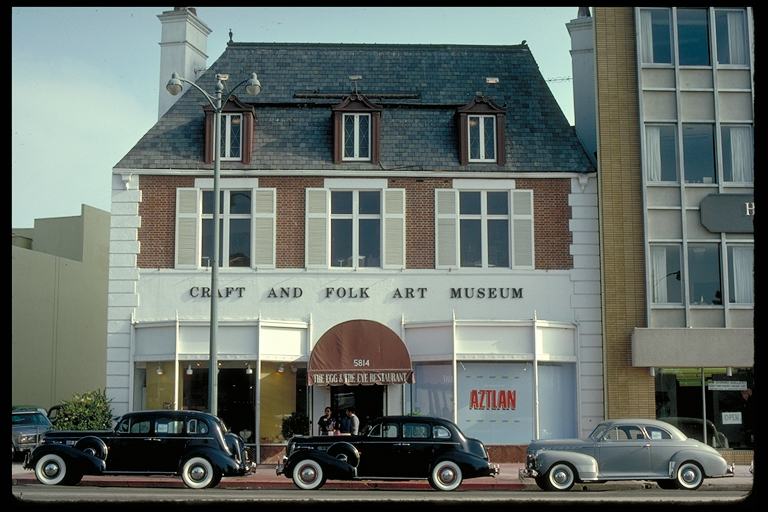- About Archives
- About SAA
- Careers
- Education
- Publications
- Advocacy
- Membership
The Craft & Folk Art Museum (CAFAM) Oral History Project provides a window into the history of an institution that is considered by many a cultural icon in Los Angeles, and into my own introduction to working with oral histories.
Two years after CAFAM held a grand re-opening celebration in 1995, it faced probable dissolution. The close would be temporary as it turned out, but no one knew that at the time. I had been CAFAM’s Museum Librarian for 21 years to that point, and had built the museum library from 300 volumes to over 7,000. As my colleagues on the staff of the small but highly-respected museum set about emptying their offices, they began to find institutional files going back to the start in 1965 of the museum’s predecessor, The Egg and The Eye Gallery. These documents were buried in desks, closets, cupboards, and file cabinets – and they consisted not just of paper files but also exhibition catalogs, slides, photos, clippings, posters, audiotapes, videos, and films.
These comprised 32 years’ worth of the museum’s raw institutional archives. Little did I know in 1997 that I would work for 14 years on the CAFAM records and that in 2008, before the records processing was finished, I would start another CAFAM project – an oral history project that would occupy me for 10 more years.
A small file of CAFAM clippings and publications existed in the museum library, but despite working with these materials and holding an M.A. in Library Science, I had never thought of myself as an archivist. I had already begun to call fellow chapter members of the Art Libraries Society of North America (ARLIS/NA), to see if anyone could provide an adoptive home for the CAFAM Research Library – and now I added the institutional files to the Request for Proposal as well.
Eight proposals were received for the library, but only three institutions could take the archives. The library was given to the L.A. County Museum of Art (LACMA) Research Library, virtually across the street. UCLA Library’s Special Collections took the archives, eventually filling 550 document boxes with materials that otherwise might have gone to the dumpster. Laid off along with the rest of the CAFAM staff, I took a part-time position at the LACMA library, allowing me to volunteer two days a week at UCLA to work on what became known as the Craft and Folk Art Museum Records: 1965-1997.
There was a happy ending for CAFAM 14 months later: The City of L.A. went into partnership with CAFAM and today, again independent, it is flourishing. CAFAM’s library remains safely folded into the LACMA library collections.
While working at UCLA on the finding aid for the CAFAM Records, it occurred to me that there were probably many “behind the scenes” stories that could be told about CAFAM’s life. I had taken an oral history course offered for graduate students by Teresa Barnett, Director of the UCLA Library’s Center for Oral History Research (COHR). When Barnett heard that I was considering creating a CAFAM oral history, she encouraged me as she realized the cultural importance of CAFAM to Los Angeles.
I interviewed 17 former CAFAM staff and board members and I was also interviewed— when the CAFAM Records processing was completed—and that interview is included in the collection. The end result, the Craft and Folk Art Museum Oral History Project, was published online on the COHR website on May 7, 2018.
Here is a link to the CAFAM Oral History Project Craft and Folk Art Museum Oral History Project: http://oralhistory.library.ucla.edu/viewItem.do?ark=21198/zz00096tgk&title=%2520Craft%2520and%2520Folk%2520Art%2520Museum%2520Oral%2520History%2520Project
The CAFAM Records: 1965 – 1997 finding aid is at: http://www.oac.cdlib.org/findaid/ark:/13030/kt5f59s1km/
Photos
Below: October, 1976--the first year of the Masked Festival, Craft and Folk Art Museum

Below: July, 1981--Murals of Aztlan, Street Painters of ‘East Los,’ Craft and Folk Art Museum
